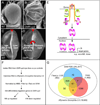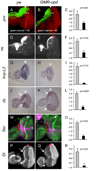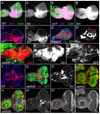Genome-wide expression profiling in the Drosophila eye reveals unexpected repression of notch signaling by the JAK/STAT pathway
- PMID: 19504457
- PMCID: PMC2846647
- DOI: 10.1002/dvdy.21989
Genome-wide expression profiling in the Drosophila eye reveals unexpected repression of notch signaling by the JAK/STAT pathway
Abstract
Although the JAK/STAT pathway regulates numerous processes in vertebrates and invertebrates through modulating transcription, its functionally relevant transcriptional targets remain largely unknown. With one jak and one stat (stat92E), Drosophila provides a powerful system for finding new JAK/STAT target genes. Genome-wide expression profiling on eye discs in which Stat92E is hyperactivated, revealed 584 differentially regulated genes, including known targets domeless, socs36E, and wingless. Other differentially regulated genes (chinmo, lama, Mo25, Imp-L2, Serrate, Delta) were validated and may represent new Stat92E targets. Genetic experiments revealed that Stat92E cell-autonomously represses Serrate, which encodes a Notch ligand. Loss of Stat92E led to de-repression of Serrate in the dorsal eye, resulting in ectopic Notch signaling and aberrant eye growth there. Thus, our micro-array documents a new Stat92E target gene and a previously unidentified inhibitory action of Stat92E on Notch signaling. These data suggest that this study will be a useful resource for the identification of additional Stat92E targets.
2009 Wiley-Liss, Inc.
Figures






Similar articles
-
JAK/STAT signaling is required for hinge growth and patterning in the Drosophila wing disc.Dev Biol. 2013 Oct 15;382(2):413-26. doi: 10.1016/j.ydbio.2013.08.016. Epub 2013 Aug 23. Dev Biol. 2013. PMID: 23978534 Free PMC article.
-
JAK/STAT signaling promotes regional specification by negatively regulating wingless expression in Drosophila.Development. 2006 Dec;133(23):4721-9. doi: 10.1242/dev.02675. Epub 2006 Nov 1. Development. 2006. PMID: 17079268
-
GFP reporters detect the activation of the Drosophila JAK/STAT pathway in vivo.Gene Expr Patterns. 2007 Jan;7(3):323-31. doi: 10.1016/j.modgep.2006.08.003. Epub 2006 Aug 22. Gene Expr Patterns. 2007. PMID: 17008134
-
JAK/STAT pathway dysregulation in tumors: a Drosophila perspective.Semin Cell Dev Biol. 2014 Apr;28:96-103. doi: 10.1016/j.semcdb.2014.03.023. Epub 2014 Mar 28. Semin Cell Dev Biol. 2014. PMID: 24685611 Free PMC article. Review.
-
Organogenesis and tumorigenesis: insight from the JAK/STAT pathway in the Drosophila eye.Dev Dyn. 2010 Oct;239(10):2522-33. doi: 10.1002/dvdy.22394. Dev Dyn. 2010. PMID: 20737505 Free PMC article. Review.
Cited by
-
Activated STAT regulates growth and induces competitive interactions independently of Myc, Yorkie, Wingless and ribosome biogenesis.Development. 2012 Nov;139(21):4051-61. doi: 10.1242/dev.076760. Epub 2012 Sep 19. Development. 2012. PMID: 22992954 Free PMC article.
-
Enhancer of Polycomb and the Tip60 complex repress hematological tumor initiation by negatively regulating JAK/STAT pathway activity.Dis Model Mech. 2019 May 30;12(5):dmm038679. doi: 10.1242/dmm.038679. Dis Model Mech. 2019. PMID: 31072879 Free PMC article.
-
Concomitant requirement for Notch and Jak/Stat signaling during neuro-epithelial differentiation in the Drosophila optic lobe.Dev Biol. 2010 Oct 15;346(2):284-95. doi: 10.1016/j.ydbio.2010.07.036. Epub 2010 Aug 6. Dev Biol. 2010. PMID: 20692248 Free PMC article.
-
Thioester-containing proteins regulate the Toll pathway and play a role in Drosophila defence against microbial pathogens and parasitoid wasps.BMC Biol. 2017 Sep 5;15(1):79. doi: 10.1186/s12915-017-0408-0. BMC Biol. 2017. PMID: 28874153 Free PMC article.
-
The Drosophila BCL6 homolog Ken and Barbie promotes somatic stem cell self-renewal in the testis niche.Dev Biol. 2012 Aug 15;368(2):181-92. doi: 10.1016/j.ydbio.2012.04.034. Epub 2012 May 8. Dev Biol. 2012. PMID: 22580161 Free PMC article.
References
-
- Agaisse H, Perrimon N. The roles of JAK/STAT signaling in Drosophila immune responses. Immunol Rev. 2004;198:72–82. - PubMed
-
- Agaisse H, Petersen UM, Boutros M, Mathey-Prevot B, Perrimon N. Signaling Role of Hemocytes in Drosophila JAK/STAT-Dependent Response to Septic Injury. Dev Cell. 2003;5:441–450. - PubMed
-
- Arbouzova NI, Bach EA, Zeidler MP. Ken & barbie selectively regulates the expression of a subset of Jak/STAT pathway target genes. Curr Biol. 2006;16:80–88. - PubMed
-
- Arbouzova NI, Zeidler MP. JAK/STAT signalling in Drosophila: insights into conserved regulatory and cellular functions. Development. 2006;133:2605–2616. - PubMed
-
- Ayala-Camargo A, Ekas LA, Flaherty MS, Baeg GH, Bach EA. The JAK/STAT pathway regulates proximo-distal patterning in Drosophila. Dev Dyn. 2007;236:2721–2730. - PubMed
Publication types
MeSH terms
Substances
Grants and funding
LinkOut - more resources
Full Text Sources
Molecular Biology Databases

